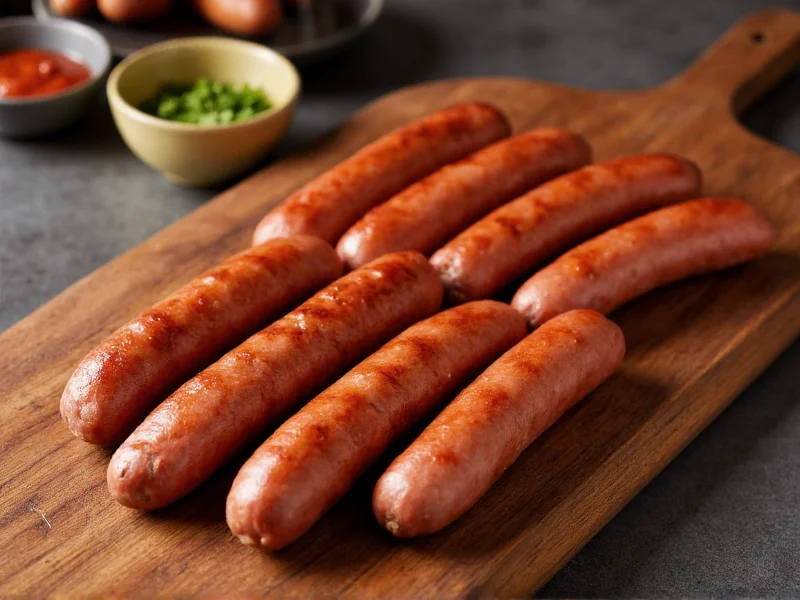Understanding smoked sausage links begins with recognizing their fundamental difference from fresh sausages. While fresh sausages require thorough cooking before consumption, smoked varieties have already been processed through smoking, which both cooks and preserves the meat. This makes them incredibly versatile for quick meal preparation.
The Smoking Process Explained
Smoking sausage involves exposing the meat to smoke from burning or smoldering wood. There are two primary methods:
| Smoking Method | Temperature Range | Result |
|---|---|---|
| Hot Smoking | 126°F to 176°F (52°C to 80°C) | Fully cooks the sausage while adding smoke flavor |
| Cold Smoking | Below 100°F (38°C) | Adds smoke flavor without cooking the meat |
Most commercially available smoked sausage links undergo hot smoking, making them fully cooked and safe to eat right out of the package. However, many people prefer to heat them further to enhance flavor and texture when preparing smoked sausage links recipes.
Smoked Sausage Links vs. Other Sausage Forms
Understanding the differences between various sausage presentations helps when selecting the right product for your needs:
- Smoked sausage links - Individual connected portions, typically 4-6 inches long, convenient for portion control and grilling
- Smoked sausage logs - Continuous tube of sausage without links, requiring slicing before cooking
- Fresh sausage links - Uncooked sausages that must be thoroughly cooked before consumption
- Kielbasa - A specific type of Polish smoked sausage, often sold in both link and log forms
When comparing smoked sausage links vs fresh sausage, the most significant difference is food safety. Smoked varieties have already been processed to eliminate harmful bacteria, while fresh sausages require cooking to an internal temperature of 160°F (71°C) for pork/beef or 165°F (74°C) for poultry.
Popular Varieties of Smoked Sausage Links
Several traditional varieties exist across different culinary traditions:
- Andouille - A spicy Cajun sausage often used in gumbo and jambalaya
- Knockwurst - A German sausage typically made with veal and pork
- Breakfast sausage links - Often milder in flavor, seasoned with sage and pepper
- Smoked chicken or turkey sausage links - Leaner alternatives to pork-based varieties
Proper Handling and Storage
Even though smoked sausage links are fully cooked, proper storage remains essential for food safety and quality:
- Refrigerate unopened packages up to 2 weeks, opened packages up to 7 days
- Freeze for up to 2-3 months for best quality
- Always check expiration dates and packaging integrity
- Store below 40°F (4°C) in the refrigerator
When storing smoked sausage links properly, keep them in their original packaging until ready to use, or transfer to an airtight container if opened. Never leave smoked sausages at room temperature for more than 2 hours (1 hour if above 90°F/32°C).
Cooking Methods for Smoked Sausage Links
While smoked sausage links are fully cooked, heating them properly enhances flavor and texture. Here are the best ways to prepare smoked sausage links:
- Grilling - Medium heat for 8-10 minutes, turning frequently for even heating
- Pan-frying - 6-8 minutes in a lightly oiled skillet over medium heat
- Baking - 20-25 minutes at 350°F (175°C) until heated through
- Simmering - 10-15 minutes in broth, beer, or sauce for added flavor
When reheating smoked sausage links safely, ensure they reach an internal temperature of 140°F (60°C). Avoid high-heat methods that might cause the casing to burst or the sausage to become dry.
Nutritional Profile
Smoked sausage links provide protein but vary in nutritional content based on meat type and seasoning. A typical 3-ounce serving of pork-based smoked sausage links contains approximately:
- 200-250 calories
- 15-20g fat (including 6-8g saturated fat)
- 12-15g protein
- 500-700mg sodium
- Minimal carbohydrates
For those monitoring sodium intake, look for low-sodium varieties or rinse smoked sausage links before cooking to remove surface salt. Chicken and turkey varieties typically contain less fat but similar sodium levels.
Culinary Applications
Smoked sausage links work well in numerous dishes beyond simple grilling. Traditional smoked sausage link recipes include:
- Breakfast plates with eggs and hash browns
- Cut into slices for pizza toppings
- Added to bean dishes like red beans and rice
- Chopped for omelets or frittatas
- Skewered with vegetables for kebabs
- Simmered in soups and stews for rich flavor
When incorporating smoked sausage links into recipes, consider their salt content when seasoning other ingredients. The smoking process creates complex flavor compounds that enhance many dishes without requiring additional heavy seasoning.
Food Safety Considerations
Despite being fully cooked, smoked sausage links require proper handling:
- Always check for signs of spoilage: slimy texture, sour smell, or discoloration
- Use within recommended time frames even if package appears intact
- Prevent cross-contamination by using separate cutting boards for raw and cooked products
- Refrigerate leftovers within 2 hours of cooking
When in doubt about the safety of smoked sausage links, follow the food safety adage: "When you see mold, throw the whole thing in the bin." Discard any sausage that shows signs of spoilage rather than attempting to cut away affected portions.











 浙公网安备
33010002000092号
浙公网安备
33010002000092号 浙B2-20120091-4
浙B2-20120091-4